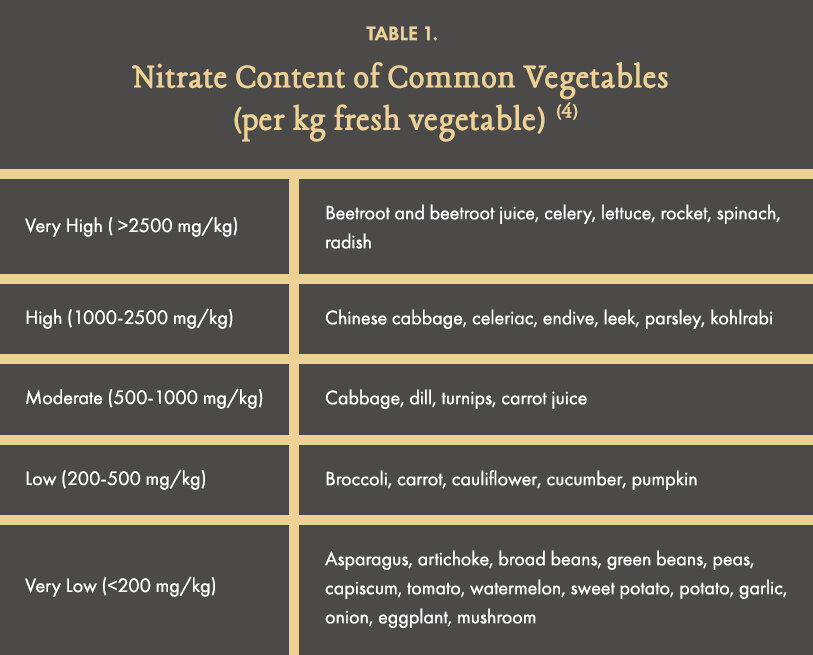Treatment of Hypertension with Beetroot Juice: Chock Full of Nitrate by Dr Scott Gerson
Within the last twenty years evidence has begun to accumulate which supports the specific health benefits of a vegetarian diet. For example in the late 1990’s, researchers found that the isothiocyanates in cruciferous vegetables (broccoli, cauliflower) protect against and possibly treat prostate (1) and other cancers.
The blood glucose-lowering effect of raw onions has been known for some time and is generally attributed to the presence of several sulfur-containing sulfoxides. These onion compounds not only lower blood sugars but also cause a small but significant increase in serum insulin.(2) More recently, investigators found that cherries have a clinically significant anti-inflammatory effect on gouty arthritis. (3)
This is only a small sampling of the good quality studies which demonstrate the healing capacity in vegetables and support the age old Ayurvedic concept of food as medicine. The most recent addition to this burgeoning body of evidence is the blood pressure-lowering effect of beets and beet juice.
The story of beet’s antihypertensive effects actually began 75 years ago with the observation that high nitrate concentration in well water used to make baby formula caused “blue baby syndrome” which turned out to be a condition known as methemoglobinemia. It’s a (reversible) condition of cyanosis caused by hemoglobin’s inability to release and deliver its oxygen to the tissues. Due to that connection scientists became aware of nitrates and its sources—mainly vegetables--of human consumption and began to warn us all to avoid high levels of nitrates in our diets. Decades later, another nitrate-related alarm was sounded with the discovery of nitrosoamines produced from nitrites (which are produced from nitrates) and certain nitrogen-containing proteins found in meats. Their formation can occur only under certain conditions, including strongly acidic conditions such as that of the human stomach or cooking or grilling meats at high temperatures. Approximately 90% of nitrosamine compounds (not nitrite or nitrate themselves) have been found to be carcinogenic, with the strongest association being with stomach and esophageal cancers.
All of this led to a somewhat sustained research activity surrounding nitrates and nitrites. One of the first findings was simply that human consumption of nitrates in food increases serum nitrite levels. It was then discovered that orally ingested nitrates in foods we eat are converted to nitrite by bacteria in the oral cavity. It is then swallowed and absorbed in the stomach and converted to nitric oxide (not to be confused with nitrous oxide or “laughing gas”). Nitric oxide is a potent vasodilator. It’s how Viagra exerts its well-known effect of increasing blood flow. In a typical person's diet, 80 percent of nitrite comes from vegetables such as beets, spinach, radishes and lettuce, and another 15 percent comes from swallowed saliva. Although in theory nitrites reaching the stomach can be converted into harmful nitrosamines due to the acidic environment, in reality the antioxidants in foods protect against this from occurring. These include: vitamins A,C, E, beta carotene, lutein, zeaxanthin, flavones, isoflavones, anthocyanins, phenolic acids, xanthones, and many others. While endogenous nitrites are no problem, we should still avoid nitrosamine-containing foods like fried bacon or grilled beef.
But what about the effect of the nitrate-nitrite-nitric oxide cascade in people with high blood pressure?
Nitrate (NO3) is one of a family of compounds containing nitrogen and oxygen that is both found in our diets and produced within our bodies. Our main dietary sources of nitrate are vegetables, processed meats (where it is added as a preservative) and the water supply. The nitrate content of water comes from decay of organic material in the soil, bacterial activity and nitrogen containing fertilizers.
Estimates of the average dietary intake of adults in the US and Europe is 1-2 mmol/d (~60-120 mg/d) with vegetables providing about 80% of this total. Vegetarians are likely to consume higher nitrate intakes than meat eaters. Table 1 summarizes the nitrate content of common vegetables from several different references:
In contrast to older (now generally discredited) fears during the 1960’s about the safety of intake of nitrates and nitrites, there is now evidence of health benefits, including indications that some of the widely accepted health benefits of a diet high in vegetables are due to its nitrate content.
Dietary nitrate is rapidly absorbed in the stomach and small intestine, with plasma nitrate levels peaking after ~ 1 hour. A significant proportion of plasma nitrate is extracted from the blood plasma by the salivary glands and concentrated in saliva where bacteria found in the tongue convert it to nitrite. The swallowing of nitrite into the acidic stomach environment starts the process in which nitrite is further processed into reactive nitrogen species including nitric oxide (NO). Plasma nitrite concentrations peak at ~ 2.5 h following the intake of dietary nitrate. Anything that interferes with salivary nitrate processing – i.e. the use of antibacterial mouthwash or chewing gum to reduce mouth levels of bacteria– will reduce this rise in plasma nitrite. The discovery of this well-established pathway of production of NO and reactive nitrogen species supports the theory that dietary nitrate is useful rather than a toxic substance.
NO is a very simple molecule with very important functions including, among others, dilating blood vessels and thereby regulating blood pressure. A 2013 study (5) of 15 grade 1 hypertensive men and women who were given beetroot juice resulted in an average decline in systolic blood pressure of approximately 12 mmHg and of 10 mmHg in diastolic pressure. After 24 hours these blood pressure effects persisted (8 mm Hg systolic reduction from baseline; 6mmHg diastolic reduction). It has been confirmed that the nitrate content of beetroot juice is the active ingredient underpinning the observed reduction in blood pressure. Larger, longer studies are needed but for now beetroot juice is definitely a valuable dietary adjunct for hypertensive individuals.
References
(1) Dong Xiao, Sanjay K. Srivastava, et.al. Allyl isothiocyanate, a constituent of cruciferous vegetables, inhibits proliferation of human prostate cancer cells by causing G2/M arrest and inducing apoptosis, Carcinogenesis (2003) 24 (5):891-897.
(2) (2) Augusti, KT, Roy, VCM, and Semple M. Effect of allyl propyl disulfide from onion (Allium cepa L.) on glucose tolerance. Experimentia, 30, 1119, 1947.(3) (3) Zhang, Y, Neogi T, Chen, C, et.al. Cherry consumption and decreased risk of recurrent gout attacks. Arthritis Rheum, 2012:64, 4004-4011.
(4) (4) Bryan NS and Hord NG (2010). Dietary Nitrates and nitrites: in: Bryan N (ed), Food Nutrition and the Nitric Oxide pathway. Destech Pub Inc: 59-77
(5) (5) Ghosh SM, Kapil, V,et.al., Enhanced vasodilator activity of nitrite in hypertension, Hypertension, 2013 April 15.



